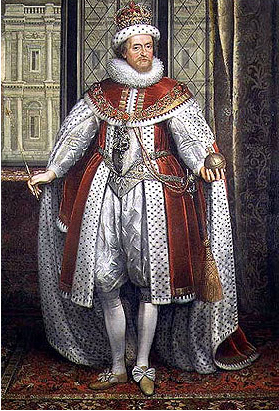|
 THE
SETON-CUNNINGHAM FEUD THE
SETON-CUNNINGHAM FEUD
It was long known
of the feud between the families of Montgomerie and Cunningham,
where the latter's Baillieship within the locality of Cunningham
had been awarded to the Master of Montgomerie during the reign
of King James III, and following which each family successively
burned the Castle-seat of the other. The feud running
generations until the titles of the Cunningham's were stripped
from them and the Montgomerie Earl of Eglinton being killed,
before Crown intervention could bring appeasement in the latter
part of the 17th century.
However during
the time of this feud, the Seton's connections with the House of
Montgomerie drew them into the Cunningham-conflict, and a feud
arose as a result. The Seton family's precedence within
the Royal Court, and having inter-married with the Montgomerie
family on serveral occasions, made them natural enemies of the
Cunningham's who seeked to restore their fortune's and position,
and quarrel's occurred between the two factions, noted in
history as riot's in both Edinburgh and Perth.
The Catholic
Seton family's support of Queen Mary Stuart, and the
Cunningham's Protestant opposition of her Majesty at Carberry
Hill and subsequent destruction of the Chapel Royal at Holyrood,
sealed the feud against each other.
From this event,
the eldest son son and heir of George, 7th Lord Seton, also
called George Seton (Master of Seton) was killed, and his
brother Robert becoming heir (and later 8th Lord Seton and 1st
Earl of Winton). Not to be forgotten of how the
Cunninghams were a part of his brother's death, he maintained
steadfastly enmatic towards the Cunningham's, and there remained
the feud between the House of Winton and Cunningham's.
How An
Edinburgh Riot Was Quelled In 1565
Lord Fountainhall, in
speaking of the evil reputation of Edinburgh as " a factious and
mutinous town " in his days, gives a very amusing anecdote of
the way in which a tumult was settled in 1555, which at that period
the 7th Lord Seton was Provost of Edinburgh. He resided at his fine old
castle in the county of East Lothian, which once had the finest
gardens in that part of Scotland.
Whilst the noble provost was taking repose at Seton, a report of
one of the Edinburgh tumults awakened him from his slumbers. The
uproar became so alarming that two of the baillies came out to
consult his lordship. Upon inquiry, Lord Seton found that the
frightened magistrates had been accessory to the riot. He,
without the slightest hesition, popped them " in the Pit"of
Seton"—"a place, observes Fountainhall, "I have seen, which was
a dreadful contumely; and
rode in presently to Edinburgh, and appeared and choked the
commotion."
The Setons were a spirited set of men, whether disguised as
Eglintons, Gordons, or Sutherlands, for all these noble families
bore that name. Indeed the Eglintons are Setons in the direct
male line and the name of Montgomery coming to them with the
Earldom under a conveyance from the last of the Montgomery
earls. J. M.
From the FEUDS OF SCOTTISH
NOBLES, 1606. * See " N. & Q." 3'" S. vii. p. 503.
Shakespeare wrote Romeo and Juliet, it is said, in 1595,
otherwise it might be imagined that the opening scene, where the
servants of the rival houses of the Montagues and Capulets fight
in the streets of Verona, had been suggested by a similar
occurrence in July, 1606, where the Cunninghames and Setonshad
by means of their " rascall seruandis" commenced a disturbance
in the streets of Perth, which with difficulty was put down by
the exertions of the Privy Council and the citizens of the
burgh.
The Parliament of Scotland did not uniformly assemble in
Edinburgh. Upon the occasion alluded to it sat in Perth upon
July 1, 1606; and James I. was duly informed how the Lords of
the Articles had been chosen according to his majesty's
pleasure, and that these persons had managed everything very
nicely. All was serene, when the Earl of Glencairn and Lord
Seton (afterwards Earl of Winton), who had a feud, broke the
peace in consequence of their servants, who participated in the
enmities of their masters, provoking a quarrel in the streets of
Perth.
The two hostile parties drew
their swords, and commenced fighting, their respective masters
joining in the melee. James had a particular detestation of all
hostile proceedings. It was, however, necessary to tell him what
had happened. This delicate task was undertaken by the Earl of
Dunbar, Lord Scone, and Sir Thomas Hamilton, Lord Advocate, and
subsequently Earl of Melros—a title he gave up for that of
Haddington. The following is an extract from their letter: —
"That grudge borne be the freindis of the houss of Eglinton to
the erle of Glencairne and his freindis is notour to your Ma"',
amangis whome thair is assurance standing, whilk mc supponed
sould haue bene ane sufficient band to haue stayed troubill and
inuasion betuix thame during thair remayning heir at this tyme.
Neuertheles vpon tysday at nicht, immediatlie efter supper, the
maister of Wintoun and his brother sir Alexander Seton, being
accumpanied with nyne or ten, going to the erle of Eglintones
ludgeing, rencontered be the way the erle of Glencairne,
accumpanied with threttie or thairby, who in respect of the
evill will borne betuix these folkis and him absteaning from all
wilfull occasion of inuasion, his lordship being in the
beginning of his cumpanie, and the maister of Winton in the
foreend of his cumpanye, past by vther, ane reasonabill spaicc,
till sum rascall seruandis in the end of thair cumpanies, being
more malicious and querrellous nor thame selfis, drew thair
swourdis and began ane tumult, whilk having tested verie long,
ended be the great travellis of the townesmen and of your
Maiesties gairde, withowt any farder skaith nor the licht
hurting of verie few and more dangerous woundis of ane Johne
Mathie, seruand to the erle of Glencairne. Whilk fact, as it wes
rerie offensiue to the haill nobilmen and counsall, in respect
of the tyme and place, so hes it in particular so grieved my
Lord Chancelor, as having dischairged hi3 brothers "sones, and
all that wes with thame, any ways to cum in his presence, so is
he als bent as any man leiving to have the trowth of the
occasion and beginning of that insolence preciselie tryed and
condignelie puneissed, withowt respect or favour of any persone."
Alexander Seton, the Lord Chancellor, was very awkwardly placed:
he was uncle of Lord Seton, and had risen to his high position
in consequence of the great love James had to the Setons who had
so faithfully served him and his mother, and who had never in
one instance swerved from their duty as loyal subjects. Thus a
breach of the peace arising out of the acts of his own near
relative must to nini have been exceedingly distressing. James
had created him in 1591 Lord Fyvie and Urquhart in Aberdeenshire,
with remainder to the heirs male of his body, whom failing, to
Sir John Seton, of Barns, his immediate elder brother, and his
heirs male ; and in 1605 he was promoted to the earldom of
Dunfermline.
How matters were ultimately smoothed we cannot explain; but one
thing is evident—that, as Lord Dunfermline continued in favour
with the king until the day of his demise, he must have found
means to pacify the two factions. J. M.
|


